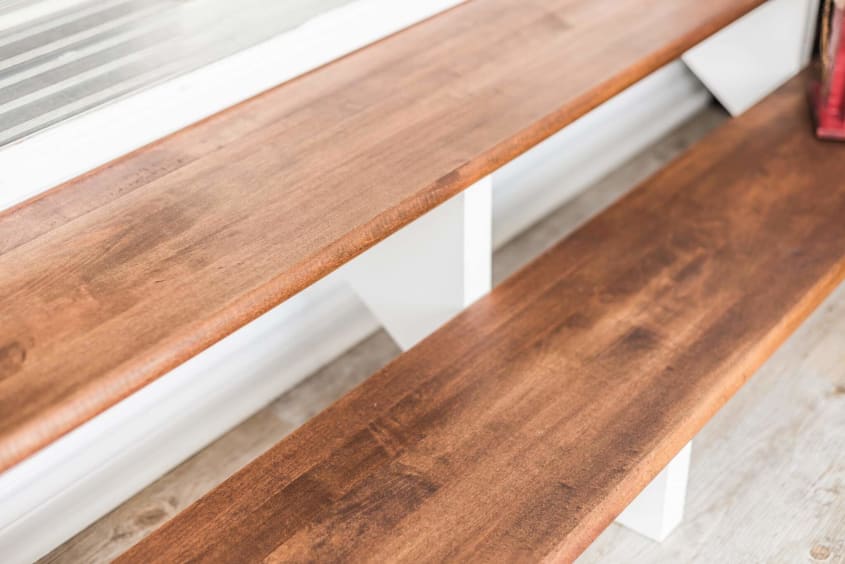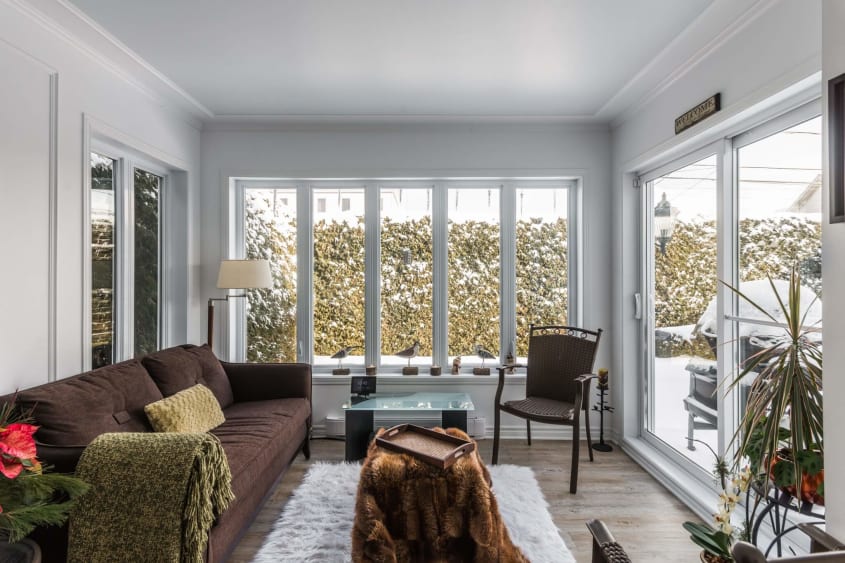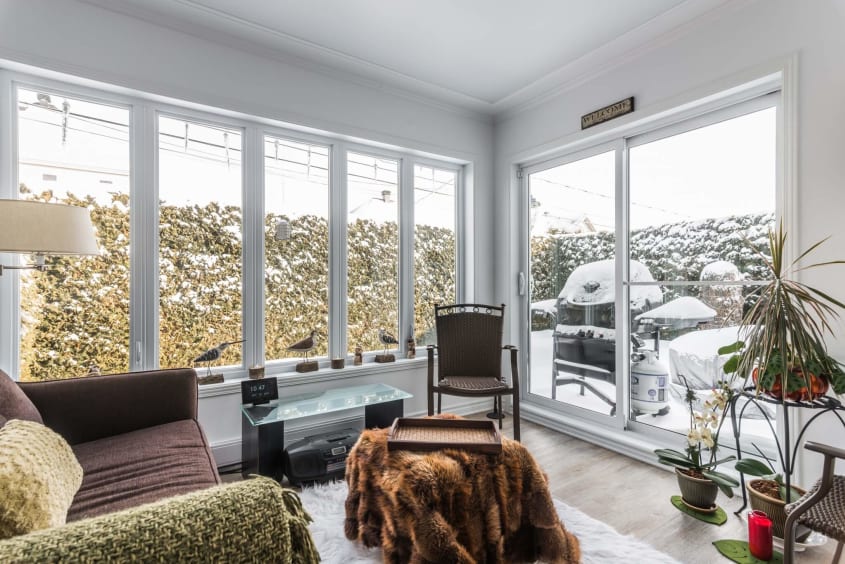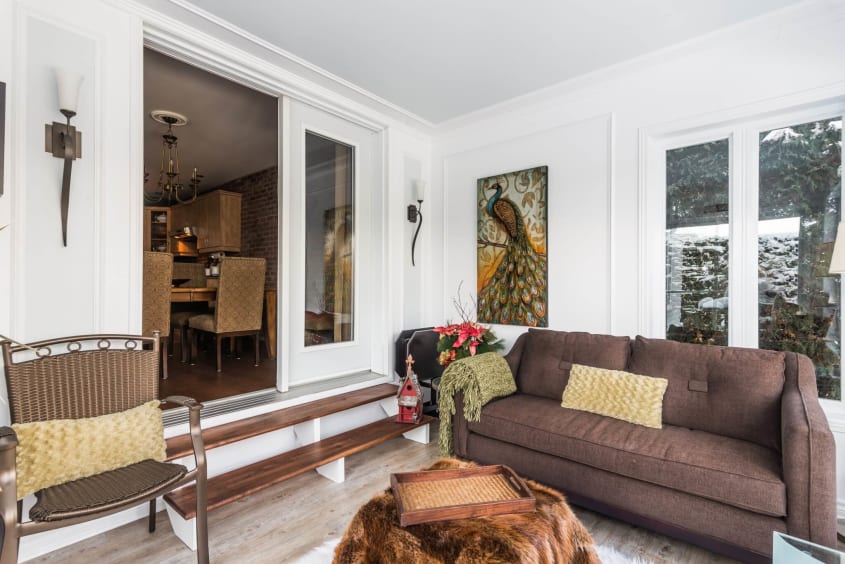A sunroom addition, also called a solarium, is a four-season room with lots of windows. It’s usually attached to the house and accessible from inside. It’s designed to function as an additional living room during mild temperatures but might be too hot or cold in the middle of summer or winter if you don’t invest in an HVAC system.
Plan your sunroom budget in advance
Before working on your sunroom addition, make sure you run it by the city and get your renovation project approved. Waiting for construction permits can be stressful, but it’s worth it. But first, let’s talk budget.
How much does a typical sunroom or solarium addition cost?
Of course, prices will vary depending on design, materials, region, and more. However, depending on where you live, the average cost of a sunroom is between $312/sq.ft. and $408/sq.ft. for Toronto or $258/sq.ft. and $336/sq.ft. for Montreal.
From what we see with our customers, an average sunroom addition will cost about $43,200 in Greater Montreal and as much as $52,800 in the Greater Toronto Area.
Keep in mind that prices will also vary based on if you plan to build a four-season room, a three-season room, a simple screened porch, or another other kind addition.
Looking for a room for all year round?
A four-season room, similar to a sunroom, is designed to be cooled and heated but is generally more expensive due to the materials and the HVAC requirements. It’s the best option if you want a great view of the outdoors and makes a wonderful home office space! It’s also a great home addition option.
Share the room with your flora in a greenhouse
Featuring the same basic structure as a solarium or four-season room, a greenhouse addition provides the light, heat, and humidity levels needed to create the perfect indoor plant room.
A more economical solution than getting a sunroom or solarium
A screened porch has walls constructed with mesh rather than glass and gives you fresh air without the bugs. Like a sunroom, it’s only really usable during mild weather.
Consider the direction of the sun while planning
Deciding on the best location for your room is the first critical step when planning a glass or screen addition. In Canada, southern exposure is best because it’ll receive the most light every day. But depending on how far south you live, the structure may require additional cooling, which can be costly.
Eastern exposure will ease cooling needs by providing sun in the morning and shade the rest of the day but isn’t the best on colder days or for after-work enjoyment.
For western exposure, however, the opposite happens. The room has strong rays in the afternoon and needs a source of shade.
Northern exposure will provide less light and partial shade most of the day. This will save cooling costs in the summer but might not be as comfortable.
Choose the right materials
Understanding a sunroom’s components will help you achieve the room you want at the right price.
Vinyl is the most popular material as it costs the least, requires minimal upkeep, and offers the best overall strength and insulation. It’s mainly available in white, leaving those wanting colour with minimal choice. Also, most vinyl supports are reinforced with either aluminum or galvanized steel.
Aluminum doesn’t provide as much insulation as vinyl and is usually more expensive. However, many rooms that use vinyl-coated vertical supports for aesthetics or added insulation do use aluminum for the roof structure for added strength.
Wood is typically the most expensive option but is also better for screened rooms because it lets you attach mesh to it with ease. Note that, for a screened room, the existing roof will need to be extended. Wood also needs periodic maintenance.
Make sure your porch is watertight
Sunrooms, four-season rooms, and greenhouses have glass walls and glass or polycarbonate (a tough, transparent thermoplastic) roofs. A glass roof is noticeably more expensive but provides the most visibility. When shopping for your solarium, look for the U-value of the glass or polycarbonate – it’ll tell you how much heat the material conducts. The lower the number, the less heat passes through. Choosing the lowest possible U-Value will ensure a more energy-efficient space.
Glass walls should be double-sealed with silicone, A-rated, and labelled “tempered safety” to meet building code requirements. These are the best choices:
Double-glazed glass. It offers durability, insulation, and glare reduction. This material’s typical U-value ranges from 2 to 2.5. Common glazing includes clear, solar bronze, and opal (from most to least efficient).
Double-glazed glass with a low-emissive coating. Glass with a low-E coating better reflects heat and ultraviolet rays. The coating reduces the U-value to around 1.7, thereby improving energy efficiency.
Double-glazed glass with argon filling and low-E coating. Argon can be added to further reduce the U-value to about 1.48.
For polycarbonate components, these are the best options:
6-millimetre twin-wall polycarbonate. This is the most popular glazing option in conservatory roofs today. This material has a U-value of 2.3.
20-millimetre and 25-millimetre twin-wall polycarbonate. For a strong and better-insulated roof, these thicknesses are great choices to create an effective all-season room. The typical U-value is 1.6.

Ensure your sunroom maintains a comfortable temperature
If you are unable to choose the optimal location to control excessive heat loss or gain, or you simply want to extend the hours you can comfortably inhabit your all-season room, consider these options:
Build walls that have several windows that can open. Choose those that will work together to allow optimum airflow.
Opt for window treatments that can be fully raised and lowered along the most troublesome wall areas.
Add operative skylights that act as heat dumps when the room gets too warm.
Install exterior roof shade tracks that hold rigid exterior sunscreens.
Intersperse prefabricated insulating roof panels among the glass roof panels. Look for R-factors of R-16, R-24, and R-32 (the higher the number, the better the insulation quality).
Install ceiling fans to aid air circulation. Go for models with forward and reverse speeds for summer or winter use.
Install a small gas wall heater in the area you will use most often during the colder months. For a more luxurious touch, install radiant floor heating.
You can give us a call on 1-888-670-9742 or submit your project online to speak to an Advisor. They will discuss your sunroom addition project with you and refer up to three verified home addition contractors to provide competing quotes for your project, ensuring that you get the best price. Best of all, our service has no fees and there’s no obligation on your part. You have nothing to lose!
Happy renovations start here!





